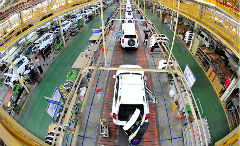China to step up deleveraging at central SOEs
2017-08-23
english.gov.cn
China will further reduce leverage at central State-owned enterprises by establishing multiple channels to reduce corporate debts, a State Council executive meeting chaired by Premier Li Keqiang decided on Aug 23.
In the first seven months of this year, central SOEs registered a profit of 846.9 billion yuan ($127.2 billion), up by 16.4 percent year-on-year, compared with a 3.7 percent drop in the same period last year. Central SOEs’ debt ratio was 66.5 percent in July, down by 0.2 percentage points from the start of this year, according to the State-owned Assets Supervision and Administration Commission of the State Council.
The performance by central SOEs in quality and efficiency improvements over the past two years has received full affirmation from the Premier.
“Central SOEs are the backbone of the economy. We need to conduct in-depth analysis to find key drivers that contribute to the transition to profits and consolidate the upward momentum,” Premier Li said.
“We should seize the opportunity and step up the deleveraging of SOEs. Lower debts can benefit the whole economy,” he added.
The meeting decided that the government will establish an alert line mechanism for debt ratios of different overly leveraged sectors. Central SOEs will face strict control over investments out of their main business portfolios and in programs that could increase their debt ratios. Enterprises that see sharp profit growth will be urged to pay down their debts. A government guideline to further reduce the debt ratios for central SOEs in an active and steady manner will also be rolled out.
The debt-for-equity swaps will be pushed forward in line with market rules and the law, and explore new market-based models for the swaps. Agencies that implement the swaps will receive support to expand their funding channels. Companies that are invested or run by State capital or qualified central SOE funds will be encouraged to take part in the swaps using various market channels.
The meeting also decided that the government will carry forward supply-side structural reform of central SOEs proactively, including absorbing excessive capacity in the steel and coal sectors and production reduction in such sectors as thermal power and aluminum smelting. Removing insolvent “zombie” enterprises will also be a priority.
There will be greater M&A efforts that encourage leading enterprises and those that are publicly listed to consolidate businesses in their own sectors.
The innovation-driven strategy will be put to fuller use as central SOEs will be encouraged to make use of innovation development funds for breakthroughs in core technologies. A number of incubators, innovation and entrepreneurship centers, online space for innovation and technological service platforms will be developed.
“Many central SOEs are engaged in traditional industries. During the transition between traditional and new growth engines, we need to achieve the transformation and upgrading into enterprises with lower leverages, lower debts and higher core competitiveness,” the Premier said.


